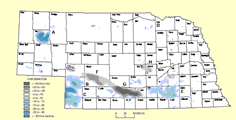Natural Resources, School of
Date of this Version
2009
Citation
Turk, J.K., and R.C. Graham. 209 Soil Carbon and Nitrogen Accumulation in a Forested Debris Flow Chronosequence, California. SSSJVolume 73: Number 5
Abstract
The role of forest soils in the biogeochemical cycling of C and N is most dynamic during the early stages of soil development. To define C and N trends that occur with soil development in a mixed coniferous forest, a chronosequence formed by debris flows was studied. The accumulation rates of total organic C (TOC) and total N (TN) were evaluated in soils on 10 debris flow deposits, ranging from depth, since this was the depth of the shallowest debris flows. Carbon was found to accumulate in the organic horizons at a rate of 26.5 g m−2 yr−1 throughout the time span of the chronosequence. Total organic C accumulation in the mineral horizons (0–30 cm) occurred from 0 to 82 yr at a rate of 13 g m−2 yr−1, and was nearly stable from 82 to 244 yr. Total N accumulated at a rate of 0.57 g m−2 yr−1 in the organic horizons and a rate of 0.17 g m−2 yr−1 in the mineral horizons (0–30 cm) throughout the 244 yr chronosequence. This study suggests that C accumulation in the upper mineral horizons of young forest soils occurs foryr, while N accumulation is a slower process that occurs for >250 yr. Carbon and N accumulation in the organic horizons, however, both follow a linear trend over the 244-yr period. The rates of C accumulation suggest a rapid recovery of the soil organic C pool following disturbance.
Included in
Geomorphology Commons, Sedimentology Commons, Soil Science Commons


Comments
RS-3172